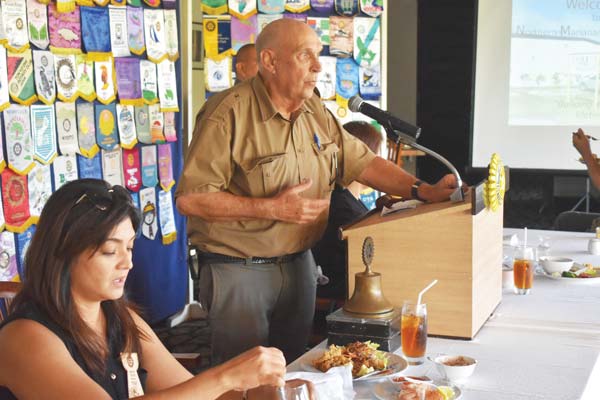‘Alternative typhoon-resistant roofing lasts decades’

Northern Marianas Trades Institute security officer Rip Stephanson delivers his presentation on typhoon-resistant alternative materials for roofing durability to the Rotary Club of Saipan Tuesday. (Erwin Encinares)
A security officer from one of the island’s local training and certification institutions recommends using different materials to construct the roofing of the houses on Saipan in order to achieve a typhoon-resistant roofing that reportedly lasts decades.
Northern Marianas Trades Institute security officer Rip Stephanson told the Rotary Club of Saipan last Tuesday that he highly recommends the usage of at least 24-gauge steel as an alternative to the common tin on wood recipe that is more popular.
“This way, you have something that lasts 30-50 years and [is able to] withstand any 200mph plus typhoon,” he said. Although he claims that the alternative method of building roofs with a higher gauge steel as an alternative to tin may seem more expensive, Stephanson noted that the price remains the same as with tin on wood but with more durability.
“…The price is the same for something that is good for 100mph and maybe [only] good for five years because wood deteriorates over time,” he said.
During his presentation to the Rotary Club, he told the members that during his computations of a standard roofing and his alternative roofing, it cost about roughly $4 per square foot for the materials.
“I constructed a sustainable roof that could probably last about 50 years by using 12-gauge C channel… 22-gauge roofing, and it turns out the cost of the materials is the same—$4 a square foot,” he said.
“Wood is expensive and is not long-lasting in this environment, so I guess it begs the question, what…are the people in the community doing about this? Because what I see is people are putting things back together in exactly the same way,” he continued.
In an interview Stephanson believes educating the community in materials that are more durable and more resistant to typhoons are a necessity, especially in the CNMI, where it is typhoon-prone.
“It’s just a matter of education. You just have to educate the hardware[s] here to have the correct materials on hand. Most of the materials are here, you just have to know where to look around [for them] to put it together, and people are starting to get the message—if you keep doing the same thing over and over expecting different results, it’s not going to happen,” he said.























